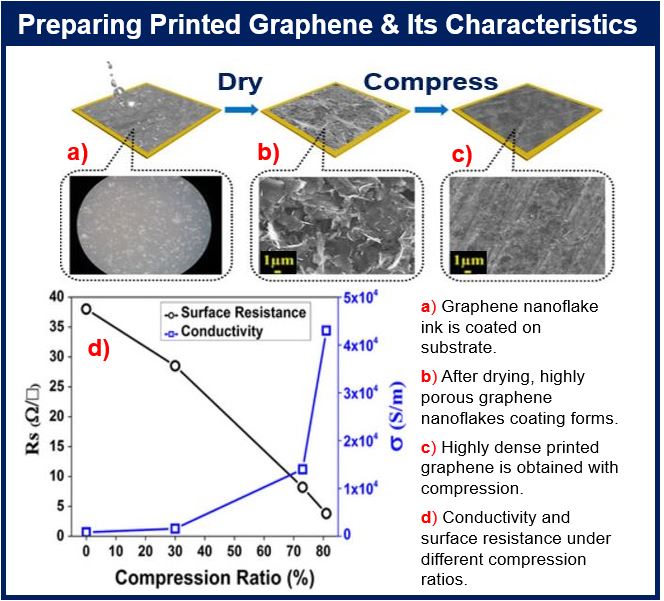Graphene wireless electronic devices can be printed onto human skin, effectively creating an on-body communications system, say scientists from the University of Manchester in England. Graphene – the world’s thinnest, hardest and lightest material – and wearable devices go hand in hand, they add. Cheap, flexible graphene communication technology, including healthcare monitors and mobile phones – printed directly onto clothing and human skin – would completely transform the world of medical care and communications.
Team leader, Dr. Zhirun Hu, from the University of Manchester’s School of Electrical and Electronic Engineering, and colleagues wrote about their breakthrough in the academic journal Scientific Reports. They claim to show how graphene could be vital to wearable electronic applications because it is ultra-flexible and highly-conductive.
Dr. Hu says this latest research may pave the way for smart, battery-free fitness and healthcare monitoring, wireless phones, internet-ready devices and charges to be incorporated into ‘smart skin’ and clothing applications.
 Graphene wireless electronic devices could have literally hundreds of different uses. (Image: www.manchester.ac.uk)
Graphene wireless electronic devices could have literally hundreds of different uses. (Image: www.manchester.ac.uk)
For example, printed graphene sensors integrated with other 2-dimensional materials could be stuck onto a patient’s skin to monitor his or her moisture levels, temperature and degrees of strain.
Below are some examples of communications devices:
– A Hospital Setting: a patient could wear a printed graphene RFID (radio frequency identification device) tag on his or her arm. The tag would be integrated with other 2D material, and would sense the patient’s heartbeat and body temperature, and send the data back to the reader.
Medical staff would be able to monitor patients’ conditions wirelessly, which would simplify patient care significantly.
– A Care Home Setting: battery-free printed graphene sensors could be printed on the clothes of elderly residents. These sensors could detect and gather elderly people’s health conditions and send the data back to the monitoring access points. This would enable remote healthcare and help improve quality of life.
Graphene is both cheap and ultra-conductive
Currently-available materials used in wearable devices are either too costly, such as silver nanoparticles, or not conductive enough to have an effect, such as conductive polymers.
Graphene, apart from being the strongest and thinnest material we know of, is also the most conductive. It is ideal for the wearables markets because of its wide range of outstanding qualities.
 Image Source: Scientific Reports.
Image Source: Scientific Reports.
Graphene conductive ink, which can be mass produced cheaply, can be printed onto clothing, paper and other materials.
Sir Kostya Novoselov, Professor of physics at the University of Manchester’s School of Physics and Astronomy, said:
“To see evidence that cheap, scalable wearable communication devices are on the horizon is excellent news for graphene commercial applications.”
Dr. Hu and team printed graphene to build transmission lines and antennas and experimented with them in communication devices, such as mobile and WiFi connectivity.
An on-body communications system
They attached graphene-enabled antennas on each arm of a mannequin. They reported that the devices could ‘talk’ to each other, effectively creating a communication system on the surface of the human body.
Their results showed that graphene-enabled components have the quality and functionality required for wireless wearable devices.
Furthermore, it is now possible to process the printed graphene at low temperature so that it is compatible with heat-sensitive flexible materials like textiles and paper.
Dr. Hu said:
“This is a significant step forward – we can expect to see a truly all graphene enabled wireless wearable communications system in the near future.”
“The potential applications for this research are huge – whether it be for health monitoring, mobile communications or applications attached to skin for monitoring or messaging.”
“This work demonstrates that this revolutionary scientific material is bringing a real change into our daily lives.”
Co-author Sir Kostya, who along with colleague Sir Andre Geim first isolated graphene in 2004 at the University, added:
“Research into graphene has thrown up significant potential applications, but to see evidence that cheap, scalable wearable communication devices are on the horizon is excellent news for graphene commercial applications.”
What is graphene?
Graphene, an amazing new material, is a single layer of pure carbon atoms. They are arranged in a six-sided (hexagonal) lattice pattern. It is the strongest material known to science – about 207 times stronger than steel. It is also the world’s lightest and thinnest material.
 Research into the potential applications of graphene is only just 10 years old. Imagine how many graphene devices there will be over the next ten years.
Research into the potential applications of graphene is only just 10 years old. Imagine how many graphene devices there will be over the next ten years.
It is so thin that scientists say it is considered to be a 2-dimensional object. According to researchers, it has limitless potential for industry, medical devices, hi-tech and several other sectors.
Graphene also has amazing electrical and thermal conductivity properties. It is unique, because apart from being incredibly strong and ultra-thin, it is also flexible.
Its potential applications include several medical, industrial and chemical processes; super-thin and flexible display screens and other optoelectronic devices; solar cells; electric circuits; lithium batteries; storing hydrogen for fuel cell powered vehicles, and hundreds of other possibilities.
Citation: “Highly Flexible and Conductive Printed Graphene for Wireless Wearable Communications Applications,” Xianjun Huang, Ting Leng, Mengjian Zhu, Xiao Zhang, JiaCing Chen, KuoHsin Chang, Mohammed Aqeeli, Andre K. Geim, Kostya S. Novoselov & Zhirun Hu. Scientific Reports 5, Article number: 18298. December 17, 2015. DOI: 10.1038/srep18298.

